See Page 1 |
2 |
3 |
4 | of the June 2023 homepage archives. Wednesday the 7th
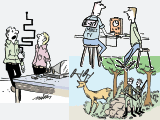 Here be a new trio of tech-themed comics,
this time from the April 1961 issue of Radio-Electronics magazine. The
one on page 69 is my favorite. In the page 85 comic, there is a squarish "U" shaped
line between the one guy's finger and the other guy's elbow, and I can't figure
out what it is supposed to be. What am I missing? The page 96 comic is kinda dumb.
Did people refer to that form of antenna as an "antler" back in the day? A firm
called MCM Manufacturing Company, in Fort Worth, Texas, made a line of mobile antennas
and support products (mounts, cables, etc.) called Antler CB Antennas, but from
what I can find they didn't come into being until the 1970s. The advertisement shown
here appeared in a 1977 issue of Popular Electronics magazine. Maybe I
missed something... Here be a new trio of tech-themed comics,
this time from the April 1961 issue of Radio-Electronics magazine. The
one on page 69 is my favorite. In the page 85 comic, there is a squarish "U" shaped
line between the one guy's finger and the other guy's elbow, and I can't figure
out what it is supposed to be. What am I missing? The page 96 comic is kinda dumb.
Did people refer to that form of antenna as an "antler" back in the day? A firm
called MCM Manufacturing Company, in Fort Worth, Texas, made a line of mobile antennas
and support products (mounts, cables, etc.) called Antler CB Antennas, but from
what I can find they didn't come into being until the 1970s. The advertisement shown
here appeared in a 1977 issue of Popular Electronics magazine. Maybe I
missed something...
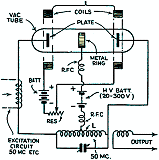 Cold cathode tubes are distinguished from
hot cathode tubes in that they do not use a separate heated element in order to
generate free electrons (thermionic heating). Rather, a "starter" type process is
used to initiate the electron generation and then a cascade multiplication keeps
the process running. Although this 1935 Short Wave Craft magazine article
reports on a cold cathode oscillator vacuum tube - designed by none other than television
pioneer Philo Farnsworth - some more familiar examples are neon and fluorescent
bulbs and even the veritable Nixie tube... Cold cathode tubes are distinguished from
hot cathode tubes in that they do not use a separate heated element in order to
generate free electrons (thermionic heating). Rather, a "starter" type process is
used to initiate the electron generation and then a cascade multiplication keeps
the process running. Although this 1935 Short Wave Craft magazine article
reports on a cold cathode oscillator vacuum tube - designed by none other than television
pioneer Philo Farnsworth - some more familiar examples are neon and fluorescent
bulbs and even the veritable Nixie tube...
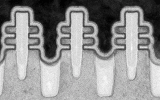 "The architecture shrinks circuits in a
valuable step toward the ultimate CMOS device. The most advanced manufacturers of
computer processors are in the middle of the first big change in device architecture
in a decade - the shift from finFETs to nanosheets. Another 10 years should bring
about another fundamental change, where nanosheet devices are stacked atop each
other to form complementary FETs (CFETs), capable of cutting the size of some circuits
in half. But the latter move is likely to be a heavy lift, say experts. An in-between
transistor called the forksheet
might keep circuits shrinking without quite as much work. The idea for the forksheet
came from exploring the limits of the nanosheet architecture, says Julien Ryckaert,
the vice president for logic technologies at Imec. The nanosheet's main feature
is its horizontal stacks of silicon ribbons surrounded by its current-controlling
gate. Although nanosheets only recently entered production..." "The architecture shrinks circuits in a
valuable step toward the ultimate CMOS device. The most advanced manufacturers of
computer processors are in the middle of the first big change in device architecture
in a decade - the shift from finFETs to nanosheets. Another 10 years should bring
about another fundamental change, where nanosheet devices are stacked atop each
other to form complementary FETs (CFETs), capable of cutting the size of some circuits
in half. But the latter move is likely to be a heavy lift, say experts. An in-between
transistor called the forksheet
might keep circuits shrinking without quite as much work. The idea for the forksheet
came from exploring the limits of the nanosheet architecture, says Julien Ryckaert,
the vice president for logic technologies at Imec. The nanosheet's main feature
is its horizontal stacks of silicon ribbons surrounded by its current-controlling
gate. Although nanosheets only recently entered production..."
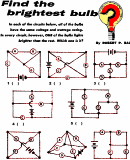 Here is a nifty little exercise that appeared
in the April 1960 edition of Popular Electronics magazine. The "Find the Brightest
Bulb Quiz" has ten different light bulb circuits and challenges you to figure out
which bulb would burn the brightest. All are intuitively obvious to most of us who
have been in the field for decades, but do you remember how to do a circuit mesh
analysis to prove your "gut?" One way to help figure out what is going on is to
re-draw the circuit to eliminate crossing lines, if possible, as in circuit numbers
2, 4, 6, and 10. Also try drawing electrically common nodes as a single connection
point, as in circuit #2 where the two nodes in the upper left and right corners
are actually the same point. Finally, try to re-arrange the circuit branches into
obvious parallel and series paths to make clear any interdependencies and independencies... Here is a nifty little exercise that appeared
in the April 1960 edition of Popular Electronics magazine. The "Find the Brightest
Bulb Quiz" has ten different light bulb circuits and challenges you to figure out
which bulb would burn the brightest. All are intuitively obvious to most of us who
have been in the field for decades, but do you remember how to do a circuit mesh
analysis to prove your "gut?" One way to help figure out what is going on is to
re-draw the circuit to eliminate crossing lines, if possible, as in circuit numbers
2, 4, 6, and 10. Also try drawing electrically common nodes as a single connection
point, as in circuit #2 where the two nodes in the upper left and right corners
are actually the same point. Finally, try to re-arrange the circuit branches into
obvious parallel and series paths to make clear any interdependencies and independencies...
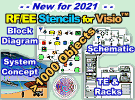 With more than 1000
custom-built stencils, this has got to be the most comprehensive set of
Visio Stencils available for RF, analog, and digital system and schematic
drawings! Every stencil symbol has been built to fit proportionally on the included
A-, B-, and C-size drawing page templates (or use your own page if preferred). Components
are provided for system block diagrams, conceptual drawings, schematics, test equipment,
racks (EIA 19", ETSI 21"), and more. Test equipment and racks are built at a 1:1
scale so that measurements can be made directly using Visio built-in dimensioning
objects. Page templates are provided with a preset scale (changeable) for a good
presentation that can incorporate all provided symbols... With more than 1000
custom-built stencils, this has got to be the most comprehensive set of
Visio Stencils available for RF, analog, and digital system and schematic
drawings! Every stencil symbol has been built to fit proportionally on the included
A-, B-, and C-size drawing page templates (or use your own page if preferred). Components
are provided for system block diagrams, conceptual drawings, schematics, test equipment,
racks (EIA 19", ETSI 21"), and more. Test equipment and racks are built at a 1:1
scale so that measurements can be made directly using Visio built-in dimensioning
objects. Page templates are provided with a preset scale (changeable) for a good
presentation that can incorporate all provided symbols...
 Aegis Power Systems is a leading supplier
of AC-DC and
DC-DC power supplies for custom and special applications. Aegis has been designing
and building highly reliable custom power supplies since 1995. They offer a complete
line of switch mode power supplies and power converters for a variety of markets
including defense, industrial, aircraft, VME, and telecom. Supports military, aircraft,
EV, telecom, and embedded computing applications. Design and manufacture of custom
power supply solutions to meet each customer's exacting specifications. Please visit
Aegis Power Systems today. Manufactured in the USA. Aegis Power Systems is a leading supplier
of AC-DC and
DC-DC power supplies for custom and special applications. Aegis has been designing
and building highly reliable custom power supplies since 1995. They offer a complete
line of switch mode power supplies and power converters for a variety of markets
including defense, industrial, aircraft, VME, and telecom. Supports military, aircraft,
EV, telecom, and embedded computing applications. Design and manufacture of custom
power supply solutions to meet each customer's exacting specifications. Please visit
Aegis Power Systems today. Manufactured in the USA.
Tuesday the 6th
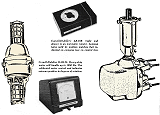 The purpose of directional antennas is not
just to increase gain along a particular radial in order to enhance weak signals,
but also to reduce gain in all other directions so as to minimize interference.
Interference can be both signals from unrelated emitters and from multipath signals
that originated from the same emitter. Hence, a directional antenna can be advantageous
in an environment where a relatively strong signal from the intended emitter is
surrounded by other strong signals. Even if the interfering signals are not on the
same frequency, the effect of raising the overall noise floor and/or generating
intermodulation products can degrade the intended signal significantly enough to
bugger audio and/or video. The solution is to
mount the receiving antenna on a rotator so that it can be pointed in a direction
which results in the best signal. Here is my Alliance U-100 Tenna−Rotor write−up
with photos... The purpose of directional antennas is not
just to increase gain along a particular radial in order to enhance weak signals,
but also to reduce gain in all other directions so as to minimize interference.
Interference can be both signals from unrelated emitters and from multipath signals
that originated from the same emitter. Hence, a directional antenna can be advantageous
in an environment where a relatively strong signal from the intended emitter is
surrounded by other strong signals. Even if the interfering signals are not on the
same frequency, the effect of raising the overall noise floor and/or generating
intermodulation products can degrade the intended signal significantly enough to
bugger audio and/or video. The solution is to
mount the receiving antenna on a rotator so that it can be pointed in a direction
which results in the best signal. Here is my Alliance U-100 Tenna−Rotor write−up
with photos...
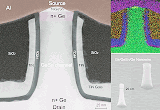 "Electrons
and other charge carriers can move faster in germanium tin than in silicon or
germanium, enabling lower operation voltages and smaller footprints in vertical
than in planar devices, say CEA-Leti researchers. This proof-of-concept breakthrough
means vertical transistors made of germanium tin are promising candidates for future
low-power, high-performance chips and possibly quantum computers. GeSn is otherwise
compatible with the existing CMOS process for chip fabrication. Because germanium
and tin come from the same periodic table group as silicon, these transistors could
be integrated directly into conventional silicon chips with existing production
lines. 'In addition to their unprecedented electro-optical properties, a major advantage
of GeSn binaries is also that they can be grown..." "Electrons
and other charge carriers can move faster in germanium tin than in silicon or
germanium, enabling lower operation voltages and smaller footprints in vertical
than in planar devices, say CEA-Leti researchers. This proof-of-concept breakthrough
means vertical transistors made of germanium tin are promising candidates for future
low-power, high-performance chips and possibly quantum computers. GeSn is otherwise
compatible with the existing CMOS process for chip fabrication. Because germanium
and tin come from the same periodic table group as silicon, these transistors could
be integrated directly into conventional silicon chips with existing production
lines. 'In addition to their unprecedented electro-optical properties, a major advantage
of GeSn binaries is also that they can be grown..."
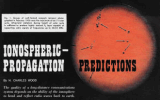 Much has been learned and published about
the various
layers of the ionosphere since its first being measured with sounding rockets
in the 1950s. Both professional and amateur communications operators are very interested
in its properties. Long term (seasonal) and short term (daily) patterns have been
discerned that help make some of the ionosphere's effect on the propagation of electromagnetic
(radio) signals somewhat predictable, but there are still many unpredictable events
that hamper - and often enhance - communications. Sun spots and coronal mass ejections,
volcanic eruptions, hurricanes, and other natural events cause sporadic changes
in the ionosphere. Real-time atmospheric propagation conditions are monitored and
reported on many websites worldwide... Much has been learned and published about
the various
layers of the ionosphere since its first being measured with sounding rockets
in the 1950s. Both professional and amateur communications operators are very interested
in its properties. Long term (seasonal) and short term (daily) patterns have been
discerned that help make some of the ionosphere's effect on the propagation of electromagnetic
(radio) signals somewhat predictable, but there are still many unpredictable events
that hamper - and often enhance - communications. Sun spots and coronal mass ejections,
volcanic eruptions, hurricanes, and other natural events cause sporadic changes
in the ionosphere. Real-time atmospheric propagation conditions are monitored and
reported on many websites worldwide...
 Antenova Ltd, the UK-based manufacturer
of antennas and RF antenna modules for M2M and the IoT, is delighted to introduce
you to
Pharaoh (SR4L073): the perfect antenna for your next 4G or 5G project. Pharaoh
is a switch-free, surface-mount (SMD) antenna which is designed to unlock the full
potential of LTE performance on limited ground planes. Pharaoh represents a significant
breakthrough in 4G/LTE antenna technology that promises to hugely improve what is
possible for devices with limited PCB real estate. This is why: Maximising Performance
Rather than being a tiny antenna requiring a large ground plane, Pharaoh enables
you to shrink the overall footprint on your design while enabling strong performance
across every 4G/LTE band including the very lowest. Gaining Certification Faster
Achieving certification for the smallest 4G/LTE devices can be an expensive and
time-consuming process. Pharaoh has been proven by an independent PTCR... Antenova Ltd, the UK-based manufacturer
of antennas and RF antenna modules for M2M and the IoT, is delighted to introduce
you to
Pharaoh (SR4L073): the perfect antenna for your next 4G or 5G project. Pharaoh
is a switch-free, surface-mount (SMD) antenna which is designed to unlock the full
potential of LTE performance on limited ground planes. Pharaoh represents a significant
breakthrough in 4G/LTE antenna technology that promises to hugely improve what is
possible for devices with limited PCB real estate. This is why: Maximising Performance
Rather than being a tiny antenna requiring a large ground plane, Pharaoh enables
you to shrink the overall footprint on your design while enabling strong performance
across every 4G/LTE band including the very lowest. Gaining Certification Faster
Achieving certification for the smallest 4G/LTE devices can be an expensive and
time-consuming process. Pharaoh has been proven by an independent PTCR...
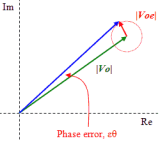 Try finding the equation for
phase
angle error due to VSWR mismatch, and you will likely fail. Extensive keyword
searches for related terms will turn up websites that present the formula for amplitude
error due to VSWR mismatch, but not for phase angle error due to VSWR mismatch.
If you are fortunate enough to find the equation, you almost certainly will not
be given the derivation. The actual equation, εθmax = |Γ1 | • |Γ2|, is so simple
that it seems unbelievable, but here its validity is demonstrated. Well, the search
is over thanks to Haris Tabakovic, who was kind enough to provide this excellent
derivation for the benefit of RF Cafe visitors... Try finding the equation for
phase
angle error due to VSWR mismatch, and you will likely fail. Extensive keyword
searches for related terms will turn up websites that present the formula for amplitude
error due to VSWR mismatch, but not for phase angle error due to VSWR mismatch.
If you are fortunate enough to find the equation, you almost certainly will not
be given the derivation. The actual equation, εθmax = |Γ1 | • |Γ2|, is so simple
that it seems unbelievable, but here its validity is demonstrated. Well, the search
is over thanks to Haris Tabakovic, who was kind enough to provide this excellent
derivation for the benefit of RF Cafe visitors...
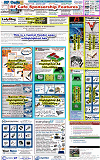 New Scheme rotates
all Banners in all locations on the page! RF Cafe typically receives 8,000-15,000
website visits each weekday.
RF Cafe is a favorite
of engineers, technicians, hobbyists, and students all over the world. With more
than 17,000 pages in the Google search index, RF Cafe returns in favorable
positions on many types of key searches, both for text and images. New content is
added on a daily basis, which keeps the major search engines interested enough to
spider it multiple times each day. Items added on the homepage often can be found
in a Google search within a few hours of being posted. If you need your company news to be seen, RF Cafe is the
place to be. New Scheme rotates
all Banners in all locations on the page! RF Cafe typically receives 8,000-15,000
website visits each weekday.
RF Cafe is a favorite
of engineers, technicians, hobbyists, and students all over the world. With more
than 17,000 pages in the Google search index, RF Cafe returns in favorable
positions on many types of key searches, both for text and images. New content is
added on a daily basis, which keeps the major search engines interested enough to
spider it multiple times each day. Items added on the homepage often can be found
in a Google search within a few hours of being posted. If you need your company news to be seen, RF Cafe is the
place to be.
 Berkeley Nucleonics Corporation (BNC) is
a leading manufacturer of precision electronic instrumentation for test, measurement,
and nuclear research. Founded in 1963, BNC initially developed custom pulse generators.
We became known for meeting the most stringent requirements for high precision and
stability, and for producing instruments of unsurpassed reliability and performance.
We continue to maintain a leadership position as a developer of custom pulse, signal,
light, and function generators. Our designs incorporate the latest innovations in
software and hardware engineering, surface mount production, and automated testing
procedures. Berkeley Nucleonics Corporation (BNC) is
a leading manufacturer of precision electronic instrumentation for test, measurement,
and nuclear research. Founded in 1963, BNC initially developed custom pulse generators.
We became known for meeting the most stringent requirements for high precision and
stability, and for producing instruments of unsurpassed reliability and performance.
We continue to maintain a leadership position as a developer of custom pulse, signal,
light, and function generators. Our designs incorporate the latest innovations in
software and hardware engineering, surface mount production, and automated testing
procedures.
Monday the 5th
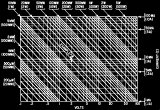 Charts and nomographs are not nearly as
useful or necessary today for the design and troubleshooting of electronics due
to the ready availability of calculators in the form of computers, tablets, and
smartphones. Determining parallel and series resistance, capacitance, and inductance,
reactance, power dissipation, resonant frequency, voltage dividers, etc., can easily
be done with the push of a few buttons (or virtual touch-sensitive screen buttons).
Not only is it not necessary to know the equations behind the calculations, but
you don't even need the know how to enter mathematical operations into a calculator.
A lot of old-schoolers say the availability of newfangled electronic gizmos contributes
to the dumbing down of technicians and engineers. If you can't use a slide rule,
then you don't truly understand the science. I wonder if their attitudes were the
same when special-purpose cardboard slide calculators and even design charts like
this one and nomographs were published? Charts and nomographs are not nearly as
useful or necessary today for the design and troubleshooting of electronics due
to the ready availability of calculators in the form of computers, tablets, and
smartphones. Determining parallel and series resistance, capacitance, and inductance,
reactance, power dissipation, resonant frequency, voltage dividers, etc., can easily
be done with the push of a few buttons (or virtual touch-sensitive screen buttons).
Not only is it not necessary to know the equations behind the calculations, but
you don't even need the know how to enter mathematical operations into a calculator.
A lot of old-schoolers say the availability of newfangled electronic gizmos contributes
to the dumbing down of technicians and engineers. If you can't use a slide rule,
then you don't truly understand the science. I wonder if their attitudes were the
same when special-purpose cardboard slide calculators and even design charts like
this one and nomographs were published?
 The introduction of low cost, small-footprint
ceramic filters were unquestionably a boon to efforts at reduction in end-product
package size and manufacturing cost. Very good Q and selectivity, no tuning required,
and good temperature stability made them perfect for use as IF filters in broadcast
radio receivers, at 10.7 MHz (FM) and 455 kHz (AM). They became available
for commercial use around 1960. This publically available paper published in 2000
from the IEEE provides some historical perspective to ceramic filters: The History
of Ceramic Filters, by Satoru Fujishima. The Clevite Corporation, for which this
Electronics World author, Reg Zimmerman worked, is mentioned in the IEEE paper,
as is Murata, for being pioneers in the ceramic filter field... The introduction of low cost, small-footprint
ceramic filters were unquestionably a boon to efforts at reduction in end-product
package size and manufacturing cost. Very good Q and selectivity, no tuning required,
and good temperature stability made them perfect for use as IF filters in broadcast
radio receivers, at 10.7 MHz (FM) and 455 kHz (AM). They became available
for commercial use around 1960. This publically available paper published in 2000
from the IEEE provides some historical perspective to ceramic filters: The History
of Ceramic Filters, by Satoru Fujishima. The Clevite Corporation, for which this
Electronics World author, Reg Zimmerman worked, is mentioned in the IEEE paper,
as is Murata, for being pioneers in the ceramic filter field...
 "Inside today's computers, phones, and other
mobile devices, more and more sensors, processors, and other electronics are fighting
for space. Taking up a big part of this valuable real estate are the cameras - just
about every gadget needs a camera, or two, three, or more. And the most space-consuming
part of the camera is the lens. The lenses in our mobile devices typically collect
and direct incoming light by refraction, using a curve in a transparent material,
usually plastic, to bend the rays. So these lenses can't shrink much more than they
already have: To make a camera small, the lens must have a short focal length; but
the shorter the focal length, the greater the curvature and therefore the thickness
at the center. These highly curved lenses also suffer from all sorts of aberrations,
so camera-module manufacturers use multiple lenses to compensate, adding to the
camera's bulk. With today's lenses, the size of the camera and image quality are
pulling in different directions. The only way to make lenses smaller and better
is to replace refractive
lenses with a different technology..." "Inside today's computers, phones, and other
mobile devices, more and more sensors, processors, and other electronics are fighting
for space. Taking up a big part of this valuable real estate are the cameras - just
about every gadget needs a camera, or two, three, or more. And the most space-consuming
part of the camera is the lens. The lenses in our mobile devices typically collect
and direct incoming light by refraction, using a curve in a transparent material,
usually plastic, to bend the rays. So these lenses can't shrink much more than they
already have: To make a camera small, the lens must have a short focal length; but
the shorter the focal length, the greater the curvature and therefore the thickness
at the center. These highly curved lenses also suffer from all sorts of aberrations,
so camera-module manufacturers use multiple lenses to compensate, adding to the
camera's bulk. With today's lenses, the size of the camera and image quality are
pulling in different directions. The only way to make lenses smaller and better
is to replace refractive
lenses with a different technology..."
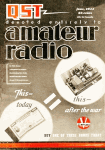 Recognizing that many people were reluctant
to approach the theoretical aspect of electronics as it applied to circuit design
and analysis, QST (the American Radio Relay League's monthly publication)
included
equations and explanations in many of their project building articles. Occasionally,
an article would be published that dealt specifically with how to use simple mathematics.
In this case, the June 1944 edition, we have the second installation of at least
a four-part tutorial that covers resistance and reactance, amplifier biasing (tubes
since the Shockley-Bardeen-Brattain trio hadn't invented the transistor yet) oscillators,
feedback circuits, etc. I do not have Part I from the May 1944 edition or Part IV
from the August 1944 edition, but if you want to send me those editions, I'll be
glad to scan and post them... Recognizing that many people were reluctant
to approach the theoretical aspect of electronics as it applied to circuit design
and analysis, QST (the American Radio Relay League's monthly publication)
included
equations and explanations in many of their project building articles. Occasionally,
an article would be published that dealt specifically with how to use simple mathematics.
In this case, the June 1944 edition, we have the second installation of at least
a four-part tutorial that covers resistance and reactance, amplifier biasing (tubes
since the Shockley-Bardeen-Brattain trio hadn't invented the transistor yet) oscillators,
feedback circuits, etc. I do not have Part I from the May 1944 edition or Part IV
from the August 1944 edition, but if you want to send me those editions, I'll be
glad to scan and post them...
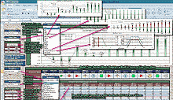 RF Cascade Workbook is the next phase in the evolution of
RF Cafe's long-running series, RF Cascade Workbook. Chances are you have
never used a spreadsheet quite like this (click here for screen capture). It is a full-featured RF system
cascade parameter and frequency planner that includes filters and mixers for a mere
$45. Built in MS Excel, using RF Cascade Workbook 2018 is a cinch
and the format is entirely customizable. It is significantly easier and faster than
using a multi-thousand dollar simulator when a high level system analysis is all
that is needed. An intro video takes you through the main features...
RF Cascade Workbook is the next phase in the evolution of
RF Cafe's long-running series, RF Cascade Workbook. Chances are you have
never used a spreadsheet quite like this (click here for screen capture). It is a full-featured RF system
cascade parameter and frequency planner that includes filters and mixers for a mere
$45. Built in MS Excel, using RF Cascade Workbook 2018 is a cinch
and the format is entirely customizable. It is significantly easier and faster than
using a multi-thousand dollar simulator when a high level system analysis is all
that is needed. An intro video takes you through the main features...
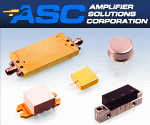 Amplifier Solutions Corporation (ASC) is
a manufacturer of amplifiers for commercial & military markets. ASC designs
and manufactures hybrid, surface mount flange, open carrier and connectorized amplifiers
for low, medium and high power applications using Gallium Nitride (GaN), Gallium
Arsenide (GaAs) and Silicon (Si) transistor technologies. ASC's thick film designs
operate in the frequency range of 300 kHz to 6 GHz. ASC offers thin film
designs that operate up to 20 GHz. ASC is located in an 8,000 sq.ft. facility
in the town of Telford, PA. We offer excellent customer support and take pride in
the ability to quickly react to evolving system design requirements. Amplifier Solutions Corporation (ASC) is
a manufacturer of amplifiers for commercial & military markets. ASC designs
and manufactures hybrid, surface mount flange, open carrier and connectorized amplifiers
for low, medium and high power applications using Gallium Nitride (GaN), Gallium
Arsenide (GaAs) and Silicon (Si) transistor technologies. ASC's thick film designs
operate in the frequency range of 300 kHz to 6 GHz. ASC offers thin film
designs that operate up to 20 GHz. ASC is located in an 8,000 sq.ft. facility
in the town of Telford, PA. We offer excellent customer support and take pride in
the ability to quickly react to evolving system design requirements.
Sunday the 4th
 This week's crossword puzzle for June 4th
sports an
electronics theme. This being the fourth day of the month, many of the words
begin and/or end with the letter "D." Besides that, we're only two days away from
"D-Day." All RF Cafe crossword puzzles are custom made by me, Kirt Blattenberger,
and have only words and clues related to RF, microwave, and mm-wave engineering,
optics, mathematics, chemistry, physics, and other technical subjects. As always,
this crossword contains no names of politicians, mountain ranges, exotic foods or
plants, movie stars, or anything of the sort unless it/he/she is related to this
puzzle's technology theme (e.g., Reginald Denny, Hedy Lamarr, or the Tunguska event
in Siberia). The technically inclined cruciverbalists amongst us will appreciate
the effort. Enjoy! This week's crossword puzzle for June 4th
sports an
electronics theme. This being the fourth day of the month, many of the words
begin and/or end with the letter "D." Besides that, we're only two days away from
"D-Day." All RF Cafe crossword puzzles are custom made by me, Kirt Blattenberger,
and have only words and clues related to RF, microwave, and mm-wave engineering,
optics, mathematics, chemistry, physics, and other technical subjects. As always,
this crossword contains no names of politicians, mountain ranges, exotic foods or
plants, movie stars, or anything of the sort unless it/he/she is related to this
puzzle's technology theme (e.g., Reginald Denny, Hedy Lamarr, or the Tunguska event
in Siberia). The technically inclined cruciverbalists amongst us will appreciate
the effort. Enjoy!
 The RFCafe.com website exists partly on the support
of its visitors by way of a small percentage earned with your
Amazon.com purchases, which typically works out to less than
$20 per month. That does not even cover the domain registration and secure server
fees for RFCafe.com. If you plan to buy items via
Amazon.com, please click on this link to begin your shopping
session from here so that I get credit for it. Doing so does not cost you anything
extra. Thank you for your support. The RFCafe.com website exists partly on the support
of its visitors by way of a small percentage earned with your
Amazon.com purchases, which typically works out to less than
$20 per month. That does not even cover the domain registration and secure server
fees for RFCafe.com. If you plan to buy items via
Amazon.com, please click on this link to begin your shopping
session from here so that I get credit for it. Doing so does not cost you anything
extra. Thank you for your support.
 Exodus Advanced Communications is a multinational
RF communication equipment and engineering service company serving both commercial
and government entities and their affiliates worldwide. Power amplifiers ranging
from 10 kHz to 51 GHz with various output power levels and noise figure
ranges, we fully support custom designs and manufacturing requirements for both
small and large volume levels. decades of combined experience in the RF field for
numerous applications including military jamming, communications, radar, EMI/EMC
and various commercial projects with all designing and manufacturing of our HPA,
MPA, and LNA products in-house. Exodus Advanced Communications is a multinational
RF communication equipment and engineering service company serving both commercial
and government entities and their affiliates worldwide. Power amplifiers ranging
from 10 kHz to 51 GHz with various output power levels and noise figure
ranges, we fully support custom designs and manufacturing requirements for both
small and large volume levels. decades of combined experience in the RF field for
numerous applications including military jamming, communications, radar, EMI/EMC
and various commercial projects with all designing and manufacturing of our HPA,
MPA, and LNA products in-house.
Friday the 2nd
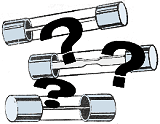 Back in the early 1990s I had my first need
as a product design engineer to
select a fuse type; it was for protecting a downconverter chassis. Having
already worked in the electronics and electrical equipment installation and maintenance
field for twenty years, I have had to replace many fuses of many different types
in many types of assemblies ranging from AC motor controls to microprocessor boards.
Slo−Blo, Fast−Blo, Standard−Blo, high voltage and low voltage, high current and
low current, glass bodied, plastic bodied, and even metal explosion-proof bodied
fuses were in the realm my experience. However, some other engineer had already
decided what the appropriate fuse was for the application. I assume each instance
had been determined from a selection process based on knowledge of both the device
to be protected and the characteristics of the fuses. Not just any fuse will do
the job. Sometimes you get lucky and the one used will work so long as the current
and voltage ratings are within the normal operational range of the product being
protected, but if that was generally the case, there wouldn't be such a large variety
of fuse types, n'est−ce pas? This "Fuses Are Not for Confusion" article from a 1960
issue of Popular Electronics magazine is a great primer on the art of fuse
selection... Back in the early 1990s I had my first need
as a product design engineer to
select a fuse type; it was for protecting a downconverter chassis. Having
already worked in the electronics and electrical equipment installation and maintenance
field for twenty years, I have had to replace many fuses of many different types
in many types of assemblies ranging from AC motor controls to microprocessor boards.
Slo−Blo, Fast−Blo, Standard−Blo, high voltage and low voltage, high current and
low current, glass bodied, plastic bodied, and even metal explosion-proof bodied
fuses were in the realm my experience. However, some other engineer had already
decided what the appropriate fuse was for the application. I assume each instance
had been determined from a selection process based on knowledge of both the device
to be protected and the characteristics of the fuses. Not just any fuse will do
the job. Sometimes you get lucky and the one used will work so long as the current
and voltage ratings are within the normal operational range of the product being
protected, but if that was generally the case, there wouldn't be such a large variety
of fuse types, n'est−ce pas? This "Fuses Are Not for Confusion" article from a 1960
issue of Popular Electronics magazine is a great primer on the art of fuse
selection...
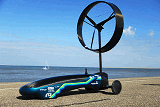 A few years ago, my local newspaper,
Erie Times-News, printed this letter that I submitted: "As an electrical engineer,
I have always embraced the technology behind wind, hydro, solar and other forms
of
'alternative' energy production. It is undoubtedly cool. What I despise is an
agenda by special interest groups to mislead the public regarding the maturity and
efficiency of those systems in an effort to destroy the nuclear and fossil fuel
industries that drive our economy. The recent failure of the 5-year-old wind turbine
at Tom Ridge Environmental Center is a good example. Numbers were not provided for
that turbine, but were for the one on Barracks Beach, also offline (Erie Times-News,
March 31). The turbine and tower cost about $36,000 in 2004 dollars, when installed.
The stated best-case energy generation for it is 15,000 kwh/ year. Electricity rates
around here are about 13 cents/kwh... A few years ago, my local newspaper,
Erie Times-News, printed this letter that I submitted: "As an electrical engineer,
I have always embraced the technology behind wind, hydro, solar and other forms
of
'alternative' energy production. It is undoubtedly cool. What I despise is an
agenda by special interest groups to mislead the public regarding the maturity and
efficiency of those systems in an effort to destroy the nuclear and fossil fuel
industries that drive our economy. The recent failure of the 5-year-old wind turbine
at Tom Ridge Environmental Center is a good example. Numbers were not provided for
that turbine, but were for the one on Barracks Beach, also offline (Erie Times-News,
March 31). The turbine and tower cost about $36,000 in 2004 dollars, when installed.
The stated best-case energy generation for it is 15,000 kwh/ year. Electricity rates
around here are about 13 cents/kwh...
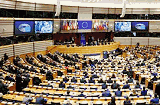 Regardless of your position on the appropriateness
of actions taken by world governments and private entities regarding the COVID 19
debacle, if you truly do "believe the science" as we were all admonished to do,
then you are obligated to avail yourself of validated, relevant data. Those of us
who had researched the issue and arrived at our own conclusions early on were routinely
condemned and demonized for daring to buck the official narrative. By all accounts
we should have expired long ago from the virus while the believers enjoy practically
eternal life from being vaxxed ... and revaxxed ... and revaxxed... Seems the opposite
has happened. Sadly, many people still have not exposed themselves to information
from other than the perpetrators of the deed. This presentation by
Dr. David Martin, at the International COVID Summit | 2023 European Parliament
will shock you (~15 minutes) regardless of your beliefs. The level of deception
and lying has been epic - with catastrophic results. If you still enthusiastically
support the official narrative, fear not, your heroes will not face any penalty.
How many weeks will be needed next time to "flatten the curve?" Regardless of your position on the appropriateness
of actions taken by world governments and private entities regarding the COVID 19
debacle, if you truly do "believe the science" as we were all admonished to do,
then you are obligated to avail yourself of validated, relevant data. Those of us
who had researched the issue and arrived at our own conclusions early on were routinely
condemned and demonized for daring to buck the official narrative. By all accounts
we should have expired long ago from the virus while the believers enjoy practically
eternal life from being vaxxed ... and revaxxed ... and revaxxed... Seems the opposite
has happened. Sadly, many people still have not exposed themselves to information
from other than the perpetrators of the deed. This presentation by
Dr. David Martin, at the International COVID Summit | 2023 European Parliament
will shock you (~15 minutes) regardless of your beliefs. The level of deception
and lying has been epic - with catastrophic results. If you still enthusiastically
support the official narrative, fear not, your heroes will not face any penalty.
How many weeks will be needed next time to "flatten the curve?"
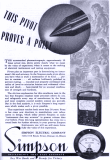 I was first introduced to the
Simpson 260 volt-ohmmeter (VOM) in the radar shop where I was assigned in the
USAF. Here is the modern version of that classic, the Simpson 260-8 VOM; it looks
a lot like the original. Here is an advertisement that I scanned out of my copy
of the July 1944 QST magazine. It highlights the precision to which its
meter movement pivots are manufactured. "While Simpson Electric Company, chartered
in 1934, is a firm with a distinguished past, it is just as importantly an organization
with a dynamic present and a definite future." There is an entire website dedicated
to the history of the Simpson 260. The famous 260 Volt-Ohm-Milliammeter put Simpson
on the map and cemented a reputation for quality that still defines Simpson in the
marketplace today." You can still buy a brand new Simpson 260 (-8) from Amazon -
and it isn't cheap - or grab a vintage Simpson Model 260 on eBay for under $100... I was first introduced to the
Simpson 260 volt-ohmmeter (VOM) in the radar shop where I was assigned in the
USAF. Here is the modern version of that classic, the Simpson 260-8 VOM; it looks
a lot like the original. Here is an advertisement that I scanned out of my copy
of the July 1944 QST magazine. It highlights the precision to which its
meter movement pivots are manufactured. "While Simpson Electric Company, chartered
in 1934, is a firm with a distinguished past, it is just as importantly an organization
with a dynamic present and a definite future." There is an entire website dedicated
to the history of the Simpson 260. The famous 260 Volt-Ohm-Milliammeter put Simpson
on the map and cemented a reputation for quality that still defines Simpson in the
marketplace today." You can still buy a brand new Simpson 260 (-8) from Amazon -
and it isn't cheap - or grab a vintage Simpson Model 260 on eBay for under $100...
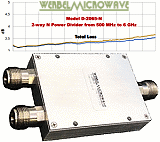 Werbel Microwave, a designer and manufacturer
of RF and microwave power couplers, dividers, terminations, and DAS equipment, introduces
the Model D−2065−N from Werbel Microwave is a
2−way power splitter covering the continuous bandwidth of 500 MHz to 6 GHz.
The product features low insertion loss of 0.9 dB, high isolation of 22 dB
and excellent return loss performance of 19 dB. Tight phase and amplitude matching
between outputs. Aluminum body with stainless steel N(F) connectors. Small size,
only 0.75 in thick, allows for dense stacking in tight spaces. Werbel Microwave's
catalog of directional couplers and power splitters / combiners are high performance
at an affordable price point. Our original design. Click here for the C-9001-8.5
spec sheet. About Werbel Microwave In-House Manufacturing Capability Werbel Microwave
started in 2014 humbly working out of a one-car garage. Since then we have grown
to occupy a 1300 square foot office and shipped over 10,000 products to date... Werbel Microwave, a designer and manufacturer
of RF and microwave power couplers, dividers, terminations, and DAS equipment, introduces
the Model D−2065−N from Werbel Microwave is a
2−way power splitter covering the continuous bandwidth of 500 MHz to 6 GHz.
The product features low insertion loss of 0.9 dB, high isolation of 22 dB
and excellent return loss performance of 19 dB. Tight phase and amplitude matching
between outputs. Aluminum body with stainless steel N(F) connectors. Small size,
only 0.75 in thick, allows for dense stacking in tight spaces. Werbel Microwave's
catalog of directional couplers and power splitters / combiners are high performance
at an affordable price point. Our original design. Click here for the C-9001-8.5
spec sheet. About Werbel Microwave In-House Manufacturing Capability Werbel Microwave
started in 2014 humbly working out of a one-car garage. Since then we have grown
to occupy a 1300 square foot office and shipped over 10,000 products to date...
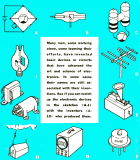 Most of these matches of the devices and
its inventor are pretty easy for people who have been around electronics for any
length of time (well, not if the length of time is only a day or two), but there
are a couple that just might stump you. This "Electronics
Inventors Quiz" appeared in the November 1963 issue of Popular Electronics
magazine, so you won't be challenged with knowing the inventors of the LCD or MEMS
devices, but neither will you have to know who came up with the abacus or the Archimedes
screw :-). I managed to score 100%, but that was admittedly partly luck in deciding
between two men for items "B" and "C." The other eight should be a piece of cake
for most RF Cafe visitors... Most of these matches of the devices and
its inventor are pretty easy for people who have been around electronics for any
length of time (well, not if the length of time is only a day or two), but there
are a couple that just might stump you. This "Electronics
Inventors Quiz" appeared in the November 1963 issue of Popular Electronics
magazine, so you won't be challenged with knowing the inventors of the LCD or MEMS
devices, but neither will you have to know who came up with the abacus or the Archimedes
screw :-). I managed to score 100%, but that was admittedly partly luck in deciding
between two men for items "B" and "C." The other eight should be a piece of cake
for most RF Cafe visitors...
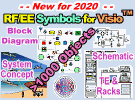 With more than 1000
custom-built symbols, this has got to be the most comprehensive set of
Visio Symbols available for RF, analog, and digital system and schematic
drawings! Every object has been built to fit proportionally on the provided
A-, B- and C-size drawing page templates (or can use your own). Symbols are provided
for equipment racks and test equipment, system block diagrams, conceptual drawings,
and schematics. Unlike previous versions, these are NOT Stencils, but instead are
all contained on tabbed pages within a single Visio document. That puts everything
in front of you in its full glory. Just copy and paste what you need on your drawing.
The file format is XML so everything plays nicely with Visio 2013 and later... With more than 1000
custom-built symbols, this has got to be the most comprehensive set of
Visio Symbols available for RF, analog, and digital system and schematic
drawings! Every object has been built to fit proportionally on the provided
A-, B- and C-size drawing page templates (or can use your own). Symbols are provided
for equipment racks and test equipment, system block diagrams, conceptual drawings,
and schematics. Unlike previous versions, these are NOT Stencils, but instead are
all contained on tabbed pages within a single Visio document. That puts everything
in front of you in its full glory. Just copy and paste what you need on your drawing.
The file format is XML so everything plays nicely with Visio 2013 and later...
 Alliance Test Equipment sells
used / refurbished
test equipment and offers short- and long-term rentals. They also offer repair,
maintenance and calibration. Prices discounted up to 80% off list price. Agilent/HP,
Tektronix, Anritsu, Fluke, R&S and other major brands. A global organization
with ability to source hard to find equipment through our network of suppliers.
Alliance Test will purchase your excess test equipment in large or small lots. Blog
posts offer advice on application and use of a wide range of test equipment. Please
visit Allied Test Equipment today to see how they can help your project. Alliance Test Equipment sells
used / refurbished
test equipment and offers short- and long-term rentals. They also offer repair,
maintenance and calibration. Prices discounted up to 80% off list price. Agilent/HP,
Tektronix, Anritsu, Fluke, R&S and other major brands. A global organization
with ability to source hard to find equipment through our network of suppliers.
Alliance Test will purchase your excess test equipment in large or small lots. Blog
posts offer advice on application and use of a wide range of test equipment. Please
visit Allied Test Equipment today to see how they can help your project.
Thursday the 1st
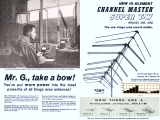 The decade of the 1960s was probably the
heyday of television. Household incomes had been steadily rising since the end of
World War II while inflation was relatively low. The Korean War was over and
until around 1965 the country was not on a serious war footing. Game shows, soap
operas, shows depicting non-dysfunctional families, variety show formats, non-woke
cartoons, movies, and newscasts that didn't insult half the country with biased
coverage fed the country's appetite for wholesome, useful entertainment. Once violent
race riots and hippie anti-establishment protests became a major threat to safety
and civic deportment, people monitored radio and television to keep abreast of events.
In accord with rapidly improving television sets were advances in
antenna technology. Viewers wanted the best possible picture and audio, and
were willing to pay dearly for it. Through around the end of the 20th century, after
which cable dominated as a transmission medium, over-the-air broadcasts in increasingly
crowded RF environments made higher performance antennas even more necessary... The decade of the 1960s was probably the
heyday of television. Household incomes had been steadily rising since the end of
World War II while inflation was relatively low. The Korean War was over and
until around 1965 the country was not on a serious war footing. Game shows, soap
operas, shows depicting non-dysfunctional families, variety show formats, non-woke
cartoons, movies, and newscasts that didn't insult half the country with biased
coverage fed the country's appetite for wholesome, useful entertainment. Once violent
race riots and hippie anti-establishment protests became a major threat to safety
and civic deportment, people monitored radio and television to keep abreast of events.
In accord with rapidly improving television sets were advances in
antenna technology. Viewers wanted the best possible picture and audio, and
were willing to pay dearly for it. Through around the end of the 20th century, after
which cable dominated as a transmission medium, over-the-air broadcasts in increasingly
crowded RF environments made higher performance antennas even more necessary...
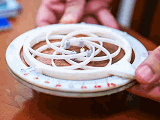 "Many situations arise in which an antenna
needs to dynamically reconfigure its center frequency or beam pattern. In some cases,
this can be done with a steerable, multi-element antenna array, but it's often not
a viable solution for various reasons. As an alternative, a team of electrical engineers
in the Penn State College of Engineering devised an innovative design for a reconfigurable
patch antenna dubbed a
reconfigurable compliant mechanism antenna (rCMA). The antenna, which leverages
the inherent elastic properties of selected material to create a desired motion
through controlled deformation, is designed to operate up to 10 GHz. These
compliant mechanisms can be made as a planar structure from a single material yet
still achieve multi-axis motion. Further, they can be designed as a full structure
with minimal or even no assembly, require no lubrication, and their reliability
is high, as it's based on the elastic properties of the material..." "Many situations arise in which an antenna
needs to dynamically reconfigure its center frequency or beam pattern. In some cases,
this can be done with a steerable, multi-element antenna array, but it's often not
a viable solution for various reasons. As an alternative, a team of electrical engineers
in the Penn State College of Engineering devised an innovative design for a reconfigurable
patch antenna dubbed a
reconfigurable compliant mechanism antenna (rCMA). The antenna, which leverages
the inherent elastic properties of selected material to create a desired motion
through controlled deformation, is designed to operate up to 10 GHz. These
compliant mechanisms can be made as a planar structure from a single material yet
still achieve multi-axis motion. Further, they can be designed as a full structure
with minimal or even no assembly, require no lubrication, and their reliability
is high, as it's based on the elastic properties of the material..."
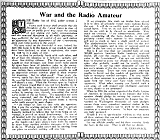 Amateur radio station operators seemed to
always be amongst the first to lose their rights in time of war. Governmental power
brokers - from unelected local bureaucrats on up to presidents - love to demonstrate
their influence over citizens when the opportunity arises. The
Radio Act of 1912 revoked the rights of amateur radio stations to operate, and
in some cases authorized the confiscation of radio equipment for use by the government.
Permission was not restored until 1919, after World War I. Amateurs took it
on the chin again in World War II with revocation of licenses. In this 1917
article in The Electrical Experimenter magazine publisher Hugo Gernsback
makes the case for permitting "our red-blooded boys be trusted to assist our officials
in running down spies." "...we realize how absurd it is to close all privately owned
radio stations during the war," says he. It fell on deaf ears, as usual. As the
now mayor of Chicago once famously said, "You never want a serious crisis to go
to waste..." Amateur radio station operators seemed to
always be amongst the first to lose their rights in time of war. Governmental power
brokers - from unelected local bureaucrats on up to presidents - love to demonstrate
their influence over citizens when the opportunity arises. The
Radio Act of 1912 revoked the rights of amateur radio stations to operate, and
in some cases authorized the confiscation of radio equipment for use by the government.
Permission was not restored until 1919, after World War I. Amateurs took it
on the chin again in World War II with revocation of licenses. In this 1917
article in The Electrical Experimenter magazine publisher Hugo Gernsback
makes the case for permitting "our red-blooded boys be trusted to assist our officials
in running down spies." "...we realize how absurd it is to close all privately owned
radio stations during the war," says he. It fell on deaf ears, as usual. As the
now mayor of Chicago once famously said, "You never want a serious crisis to go
to waste..."
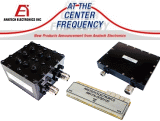 Anatech Electronics offers the industry's
largest portfolio of high-performance standard and customized
RF and microwave filters and filter-related products for military, commercial,
aerospace and defense, and industrial applications up to 40 GHz. Three new
filter models have been introduced - a 1176 MHz / 1575 MHz ceramic duplexer with
an 18 MHz minimum bandwidth, a 1616 - 1626.5 MHz cavity bandpass filter with
TNC female connectors, and a 4900 MHz bandpass filter with N-type male / N-type
female connectors. Custom RF power filter and directional couplers designs can be
designed and produced with required connector types when a standard cannot be found,
or the requirements are such that a custom approach is necessary... Anatech Electronics offers the industry's
largest portfolio of high-performance standard and customized
RF and microwave filters and filter-related products for military, commercial,
aerospace and defense, and industrial applications up to 40 GHz. Three new
filter models have been introduced - a 1176 MHz / 1575 MHz ceramic duplexer with
an 18 MHz minimum bandwidth, a 1616 - 1626.5 MHz cavity bandpass filter with
TNC female connectors, and a 4900 MHz bandpass filter with N-type male / N-type
female connectors. Custom RF power filter and directional couplers designs can be
designed and produced with required connector types when a standard cannot be found,
or the requirements are such that a custom approach is necessary...
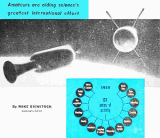 The
International Geophysical Year (IGY) was an international scientific project
that took place from July 1, 1957, to December 31, 1958. It was a collaborative
effort involving scientists from around the world to conduct research in various
fields of geophysics. The IGY was organized in response to a proposal by the International
Council of Scientific Unions (ICSU) to promote international cooperation in the
study of the Earth and its environment. The project aimed to advance our understanding
of Earth's physical properties, including its atmosphere, oceans, and solid Earth.
During the IGY, scientists conducted research in a wide range of disciplines, such
as meteorology, seismology, glaciology, oceanography, and solar physics. They used
cutting-edge technologies and established numerous research stations across the
globe to gather data. One of the most significant achievements of the IGY was the
International Geophysical Year Antarctic Program. Several countries established
research bases in Antarctica, leading to significant discoveries about the continent's
geology, weather patterns, and wildlife... The
International Geophysical Year (IGY) was an international scientific project
that took place from July 1, 1957, to December 31, 1958. It was a collaborative
effort involving scientists from around the world to conduct research in various
fields of geophysics. The IGY was organized in response to a proposal by the International
Council of Scientific Unions (ICSU) to promote international cooperation in the
study of the Earth and its environment. The project aimed to advance our understanding
of Earth's physical properties, including its atmosphere, oceans, and solid Earth.
During the IGY, scientists conducted research in a wide range of disciplines, such
as meteorology, seismology, glaciology, oceanography, and solar physics. They used
cutting-edge technologies and established numerous research stations across the
globe to gather data. One of the most significant achievements of the IGY was the
International Geophysical Year Antarctic Program. Several countries established
research bases in Antarctica, leading to significant discoveries about the continent's
geology, weather patterns, and wildlife...
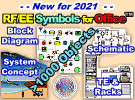 It was a lot of work, but I finally finished
a version of the "RF & Electronics Schematic & Block Diagram Symbols" that
works well with Microsoft Office™ programs Word™, Excel™, and Power Point™.
This is an equivalent of the extensive set of amplifier, mixer, filter, switch,
connector, waveguide, digital, analog, antenna, and other commonly used symbols
for system block diagrams and schematics created for Visio™. Each of the 1,000 or
so symbols was exported individually from Visio in the EMF file format, then imported
into Word on a Drawing Canvas. The EMF format allows an image to be scaled up or
down without becoming pixelated, so all the shapes can be resized in a document
and still look good. The imported symbols can also be UnGrouped into their original
constituent parts for editing. Check them out! It was a lot of work, but I finally finished
a version of the "RF & Electronics Schematic & Block Diagram Symbols" that
works well with Microsoft Office™ programs Word™, Excel™, and Power Point™.
This is an equivalent of the extensive set of amplifier, mixer, filter, switch,
connector, waveguide, digital, analog, antenna, and other commonly used symbols
for system block diagrams and schematics created for Visio™. Each of the 1,000 or
so symbols was exported individually from Visio in the EMF file format, then imported
into Word on a Drawing Canvas. The EMF format allows an image to be scaled up or
down without becoming pixelated, so all the shapes can be resized in a document
and still look good. The imported symbols can also be UnGrouped into their original
constituent parts for editing. Check them out!
 Withwave manufactures an extensive line
of metrology quality coaxial test cable assemblies, connectors (wave-, end-, vertical-launch,
board edge, panel mount), calibration kits (SOLT), a
fully automated
4-port vector network analyzer (VNA) calibrator, between- and in-series connector
adaptors, attenuators, terminations, DC blocks, torque wrenches, test probes &
probe positioner. Special test fixtures for calibration and multicoax cable assemblies.
Frequency ranges from DC through 110 GHz. Please contact Withwave today to
see how they can help your project succeed. Withwave manufactures an extensive line
of metrology quality coaxial test cable assemblies, connectors (wave-, end-, vertical-launch,
board edge, panel mount), calibration kits (SOLT), a
fully automated
4-port vector network analyzer (VNA) calibrator, between- and in-series connector
adaptors, attenuators, terminations, DC blocks, torque wrenches, test probes &
probe positioner. Special test fixtures for calibration and multicoax cable assemblies.
Frequency ranges from DC through 110 GHz. Please contact Withwave today to
see how they can help your project succeed.
These archive pages are provided in order to make it easier for you to find items
that you remember seeing on the RF Cafe homepage. Of course probably the easiest
way to find anything on the website is to use the "Search
RF Cafe" box at the top of every page.
About RF Cafe.
Homepage Archive Pages
2024:
Jan |
Feb |
Mar |
Apr |
May |
Jun |
Jul |
Aug |
Sep |
Oct |
Nov |
Dec
2023:
Jan |
Feb |
Mar |
Apr |
May |
Jun |
Jul |
Aug |
Sep |
Oct |
Nov |
Dec
2022:
Jan |
Feb |
Mar |
Apr |
May |
Jun |
Jul |
Aug |
Sep |
Oct |
Nov |
Dec
2021:
Jan |
Feb |
Mar |
Apr |
May |
Jun |
Jul |
Aug |
Sep |
Oct |
Nov |
Dec
2020:
Jan |
Feb |
Mar |
Apr |
May |
Jun |
Jul |
Aug |
Sep |
Oct |
Nov |
Dec
2019:
Jan |
Feb |
Mar |
Apr |
May |
Jun |
Jul |
Aug |
Sep |
Oct |
Nov |
Dec
2018:
Jan |
Feb |
Mar |
Apr |
May |
Jun |
Jul |
Aug |
Sep |
Oct |
Nov |
Dec
2017:
Jan | Feb |
Mar |
Apr |
May |
Jun |
Jul |
Aug |
Sep |
Oct |
Nov |
Dec
2016:
Jan |
Feb |
Mar |
Apr |
May |
Jun |
Jul |
Aug |
Sep |
Oct |
Nov |
Dec
2015:
Jan |
Feb |
Mar |
Apr |
May |
Jun |
Jul |
Aug |
Sep |
Oct |
Nov |
Dec
2014:
Jan |
Feb |
Mar |
Apr |
May |
Jun |
Jul |
Aug |
Sep |
Oct |
Nov |
Dec
2013:
Jan |
Feb |
Mar |
Apr |
May |
Jun |
Jul |
Aug |
Sep |
Oct |
Nov |
Dec
2012:
1 |
2 |
3 |
4 |
5 |
6 |
7 |
8 |
9 |
10 |
11 |
12 |
13 (no archives before 2012)
|

 Cold cathode tubes
Cold cathode tubes









 Berkeley Nucleonics Corporation (BNC)
Berkeley Nucleonics Corporation (BNC) Charts and nomographs
Charts and nomographs






 Exodus Advanced Communications
Exodus Advanced Communications













